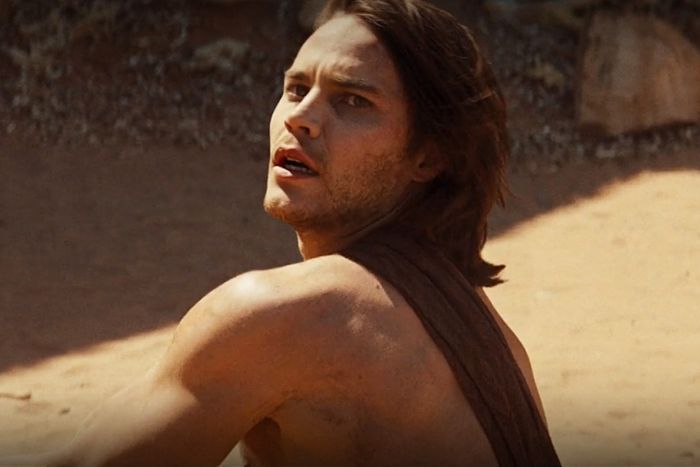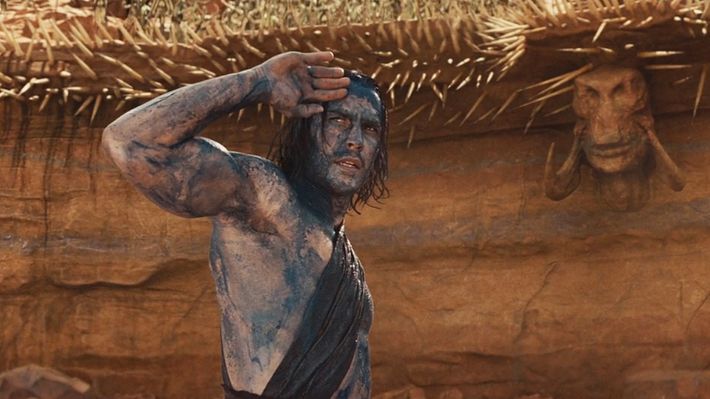
Every two weeks for the foreseeable future, Vulture will be selecting a film to watch with our readers as part of our Wednesday Night Movie Club. This week’s selection comes from writer Roxana Hadadi, who will begin her screening of John Carter on March 9 at 7 p.m. ET. Head to Vulture’s Twitter to catch the live commentary.
There was a brief, delightful time in the early 2010s, before the expanded Marvel Cinematic Universe and the Star Wars film franchise had fully secured their formulaic stranglehold on the blockbuster as we know it, when Walt Disney Pictures was still willing to get weird with its big-budget, live-action theatrical releases. It wasn’t always good, to be honest. Alice in Wonderland shaved minutes off all our lives by inventing a breakdancing Mad Hatter. Prince of Persia: The Sands of Time broke new ground in whitewashing, and The Lone Ranger’s leading duo of Armie Hammer and Johnny Depp now seems rather cursed.
But there are treasures hidden amid this era of rubble, too. Nicolas Cage is an utter delight as a modern-day Merlin in The Sorcerer’s Apprentice. Tron: Legacy is a fantastical neon dream with a soundtrack from Daft Punk that still resembles a frequency beamed in from a faraway world. And John Carter, the colossal bomb that lost Disney $200 million, now seems far from the creative disaster it was dismissed as back in 2012. Meticulously crafted and earnestly conceived, John Carter presents its protagonists as agents of chaotic good in a place and a time that don’t always reward such morality. The result is a satisfyingly goofy throwback epic that uses the big feelings at its center — love, regret, courage — for immersion and intimacy.
Every scene in filmmaker Andrew Stanton’s passion project pulses with vibrant life and megasize emotion: the Lawrence of Arabia–mimicking narrative of a military-trained white man being exalted by an Indigenous community, the capital-R Romance. Every frame pushes the limits of contemporaneous special effects: the crowds of Tharks crowding desert camps and arenas, the large-scale battle scenes between dragonfly-winged ships. And every moment relies on the roguish smile, gentle heroism, and tangible physicality of Taylor Kitsch, whose ascent to A-list stardom came to a thumping halt after the double-whammy box-office failures of John Carter and Battleship.
The latter film from Peter Berg was a scraping-the-IP-barrel project that even a deep ensemble cast (including Kitsch, Alexander Skarsgård, Jesse Plemons, and Hamish Linklater) couldn’t save. But in John Carter, based on Edgar Rice Burroughs’s 1912 novel A Princess of Mars, Kitsch’s enthusiasm is infectious. The film tosses at him one strange thing after another from Burroughs’s expansive imagination. As the titular former Confederate Army captain turned interplanetary traveler, Kitsch’s reactions to his new ability to fly leaps and bounds in the air, to being treated as a hatchling infant by the green Martian Tharks, and to fighting for his life in a gladiator arena all have a winking “Can you believe this shit?” vibe. That slow half-smirk and raised eyebrow — Kitsch hallmarks from his time as Tim Riggins on Friday Night Lights — reassure us that, yes, this is all outlandish. But they also promise that, yes, this spin on the swashbuckling genre will be worth it. Lucky for us, he’s right.
You just have to get through the beginning of the film, which cycles through three different introductions before settling in. First: Mars as Barsoom, a planet caught in 1,000 years of civil war between good city Helium and bad city Zodanga while desert tribes of Tharks watch “red men” kill one another. Second: New York City in 1881, where a suavely dressed John Carter evades the tail pursuing him but then mysteriously dies, leaving his journal to his nephew Ned, a nickname for Edgar (Daryl Sabara). Yes, this is a meta moment in which the author of the book version of this story is now in the movie version of this story. Third: After all this setup, John Carter gets properly going when Ned starts to read his uncle’s journal and the narrative jumps back in time to the Territory of Arizona in 1868 and then, finally, back to Barsoom.
The mechanics of how Carter is transported from a cramped cave on Earth to a rocky valley on the Red Planet do matter from a plot perspective. There’s a magical medallion, and some stuff about Barsoom’s religious beliefs, and shape-shifting alien baddies led by Mark Strong, and this gigantic holy tree that looks simultaneously organic and carved out of circuit boards. (This film was “dedicated to the memory of Steve Jobs,” after all.) But one could ignore the somewhat convoluted plot to focus only on how effectively John Carter shifts into adventure mode and how entertaining Kitsch is as a cross between Brendan Fraser in The Mummy and Vin Diesel in The Chronicles of Riddick, and honestly one should.
Kitsch isn’t in every single one of the film’s 132 minutes, but John Carter is so reliant on the tension caused by his literal and figurative transformation from Earthman to Mars Guy that it’s better when he is. When the film positions Carter as a stranger in a strange land, with a supercut of embarrassing trips, stumbles, and falls to the ground as he struggles to acclimate to altered gravity. When the bathing ritual administered by the Tharks includes a plume of powdered soap to the face and a gigantic bottle of psychedelic milk. When it asks him to be protective (saving Lynn Collins’s Princess Dejah Thoris from more than one fall off a spaceship) or ruthless (slicing and dicing foes while chained up as a gladiator). And a scene where Kitsch encircles Collins’s body with his arms during a forbidden little jaunt to a Thark temple? Blasphemy never looked so good!
As a film, John Carter doesn’t hide its myriad influences — Dune, Return of the Jedi, Dances With Wolves — and it doesn’t reinvent the fantasy genre so much as just remind us of Burroughs’s influential role in crafting it in the first place. Still, the resulting mishmash of steampunk ship design, Orientalist architecture, and tiptoeing-toward-fetishwear costuming remains unlike anything Disney has dared to release in the decade since. Absorbing a couple hundred million dollars in losses from a single movie has a way of making a studio a little more conservative, and as Disney’s risk-taking diminished after John Carter, so too did Kitsch’s attempts at a leading-man career. That was a shame then, and it is still a shame now. Join me in revisiting the familiar-yet-immersive, goofy-yet-ambitious John Carter and admiring how Kitsch carries the film on those appreciably muscled shoulders; I’ll save you and “nice monster dog” Woola a seat.
More From This Series
- No Movie Captures the Essence of Neil Young’s Best Songs Like Inherent Vice
- The Action-Goth Masterpiece That Never Got Its Due
- Without Brandon Lee, The Crow Doesn’t Fly



